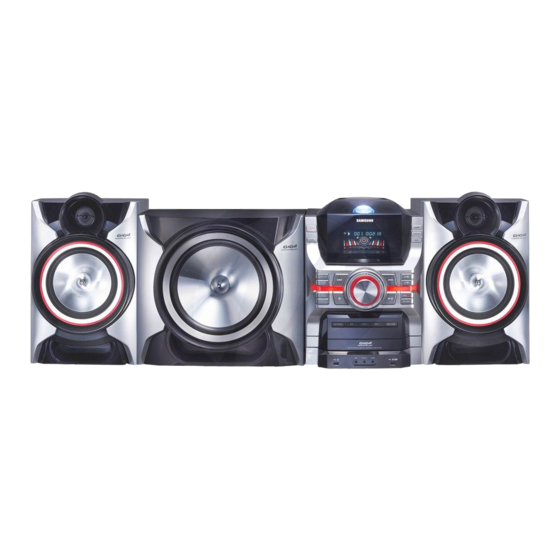Table of Contents
Advertisement
Advertisement
Table of Contents

Summarization of Contents
Safety Warnings
General Safety Precautions
Essential safety instructions for preventing electric shock, fire, and injury.
Laser Safety Information
Information on laser product classification and potential radiation hazards.
System Precautions and Compatibility
General Operating and Disc Handling
Guidelines for safe operation, disc handling, and storage.
Disc Type Compatibility
Information on playing CD-R, CD-R MP3, and WMA discs.
Component Identification
Front Panel Controls
Detailed explanation of the front panel buttons and indicators.
Rear Panel Connections
Speaker Terminals
Information on connecting speakers to the rear terminals for audio output.
Input/Output Ports
Details on various input/output ports for connecting external devices and antennas.
Cooling Fan
Information about the cooling fan and its ventilation requirements.
Remote Control Functions
Remote Control Buttons
Explanation of the buttons on the remote control and their respective operations.
Display Mode Selection
How to view and adjust system information and display modes.
Microphone and Speaker Setup
Connecting a Microphone
Guide on connecting and using a microphone for karaoke or vocal input.
Stacking Speakers (MX-E870/E871)
Instructions for physically assembling and stacking the speakers.
Disc Management
Loading and Changing Discs
Step-by-step guide on how to load, change, and unload discs.
CD/MP3/WMA-CD Playback
Instructions for playing audio CDs, MP3, and WMA files.
Disc Navigation and Playback Features
Selecting CDs and Tracks
How to choose a CD and a specific track to play.
Searching Tracks and Folders
Efficiently locating tracks, folders, and specific music passages.
Repeat Playback Options
Methods for repeating tracks, discs, or specific sections of a track.
Advanced CD and Auto Playback Features
Track Skipping and Programming
How to skip tracks and set custom playback orders for CDs.
Programmed Track Management
Viewing and modifying previously programmed track sequences.
Auto Change Function
Enables continuous playback across discs and USB devices.
USB Device Operations
Playing USB Files
Connect and play music files from USB storage devices.
USB File Management
Features for searching, deleting, and skipping files on USB devices.
USB Storage Guidelines
Important notes and compatibility information for using USB devices.
Radio and Clock Setup
Listening to Radio Stations
Instructions for tuning into FM and AM radio stations.
Stored Station Selection
How to access and play pre-saved radio stations.
Setting the Clock
Guide to setting the system's internal clock and time.
Timer and Alarm Functions
Setting the Timer
Setting the system to turn on or off automatically at specific times.
Cancelling the Timer
Steps to disable or cancel the set timer functions.
Recording to USB Device
Recording Function Overview
Instructions for recording audio from CDs, radio, or external sources to USB.
Recording Speed Selection
Options for selecting the speed at which recordings are made.
System Sound and Lighting Features
Equalizer Settings
Applying predefined or custom equalizer settings for various music genres.
Special Sound Modes
Engaging Dynamic, Stadium, and Giga Sound modes for enhanced audio.
LED Lighting Control
Controlling the system's LED lighting effects and modes.
Party Mode and Troubleshooting
Party Function
Activating different party modes for enhanced audio and visual effects.
Troubleshooting Guide
Solutions for common issues and problems encountered with the system.












Need help?
Do you have a question about the MX-E871 and is the answer not in the manual?
Questions and answers